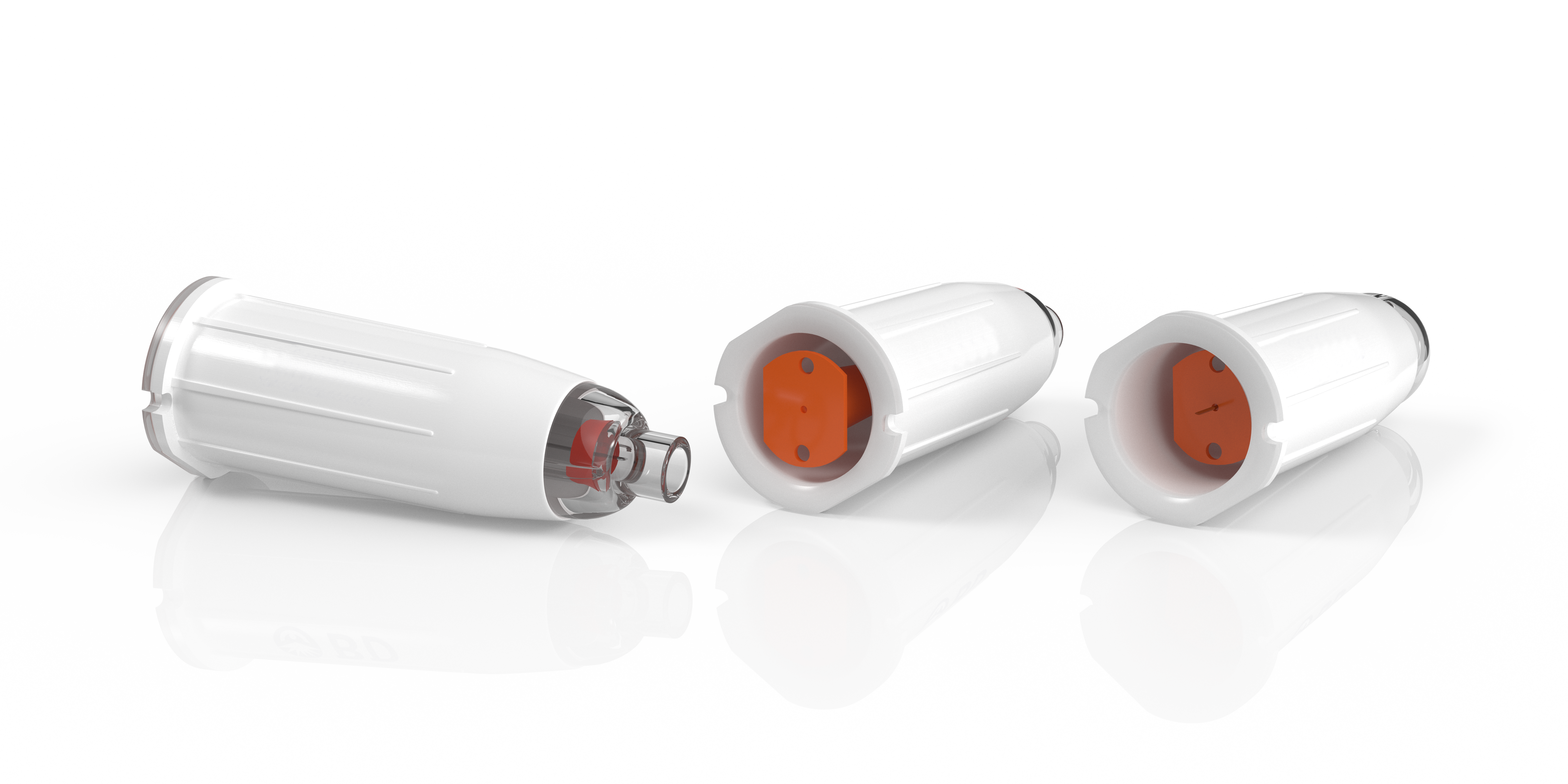The BD AutoShield Duo™ pen needle is a safety pen needle that comes in a 5-mm size to facilitate safer insulin injections.1 Featuring patented automatic dual-protection shields on both ends of the needle, it helps prevent needlestick exposure and injury during injection and disposal. Conveniently, the BD AutoShield Duo pen needle is compatible with leading diabetes medication pens in Canada.

- Overview
- Products & Accessories
- EIFU & Resources
Needle concealment
An outer shield conceals the 5-mm single-use needle, so patients do not need to see it or feel intimidated by it.
Reduced risk of needlestick injury
The pen needle features shields over both the front-end and back-end needles, and does not require a pinch-up*—which all help prevent needlestick injury.
Large barrel
The pen needle features a large barrel for easy handling and attachment.
Red indicator band
After users finish performing the injection and lift the pen needle away from the skin, the pen's inner shield automatically deploys and locks. A red indicator band then confirms that the shield is locked and the needle has been used.
Reduced IM injection risk
By delivering subcutaneous injections, the 5-mm pen needle helps reduce the risk of intramuscular (IM) injections that can increase the risk of hypoglycemia in patients, regardless of their body mass index (BMI).1–3
Thin wall technology
Our needles retain their extremely fine external dimensions but with a wider inner diameter, improving insulin flow rate and requiring less force.4
Rigorous testing
The pen needle is rigorously tested for fit, function and dose accuracy.
Single-handed injection technique
Because the BD AutoShield Duo pen needle does not require a pinch-up technique, the risk of needlestick injury during injection may be reduced.
Please note, not all products, services or features of products and services may be available in your local area. Please check with your local BD representative.
Notes
* Children from 2 to 6 years old, extremely lean adults or people with loose skin may need to use a pinch-up technique.
† Users must avoid placing their fingers on either end of the pen needle shields.
References
- Gibney MA, Arce CH, Byron KJ, Hirsch LJ. Skin and subcutaneous adipose layer thickness in adults with diabetes at sites used for insulin injections: implications for needle length recommendations. Curr Med Res Opin. 2010;26(6):1519-1530.
- Frid A, Hirsch L, Gaspar R, et. al. New injection recommendations for patients with diabetes. Diabetes Metab. 2010;36 Suppl 2:S3-S18.
- Karges B, Boehm BO, Karges W. Early hypoglycemia after accidental intramuscular injection of insulin glargine. Diabet Med. 2005;22(10):1444-1445.
- Aronson R, Gibney MA, Oza K, Bérubé J, Kassler-Taub K, Hirsch L. Insulin pen needles: effects of extra-thin wall needle technology on preference, confidence and other patient ratings. Clin Ther. 2013;35(7):923-933.
- Occupational Safety and Health Administration. Bloodborne pathogens. 29 CFR §1910.1030. https://www.osha.gov/pls/oshaweb/owadisp.show_document?p_table=STANDARDS&p_id=10051.
Please note, not all products, services or features of products and services may be available in your local area. Please check with your local BD representative.
Notes
* Children from 2 to 6 years old, extremely lean adults or people with loose skin may need to use a pinch-up technique.
† Users must avoid placing their fingers on either end of the pen needle shields.
References
- Gibney MA, Arce CH, Byron KJ, Hirsch LJ. Skin and subcutaneous adipose layer thickness in adults with diabetes at sites used for insulin injections: implications for needle length recommendations. Curr Med Res Opin. 2010;26(6):1519-1530.
- Frid A, Hirsch L, Gaspar R, et. al. New injection recommendations for patients with diabetes. Diabetes Metab. 2010;36 Suppl 2:S3-S18.
- Karges B, Boehm BO, Karges W. Early hypoglycemia after accidental intramuscular injection of insulin glargine. Diabet Med. 2005;22(10):1444-1445.
- Aronson R, Gibney MA, Oza K, Bérubé J, Kassler-Taub K, Hirsch L. Insulin pen needles: effects of extra-thin wall needle technology on preference, confidence and other patient ratings. Clin Ther. 2013;35(7):923-933.
- Occupational Safety and Health Administration. Bloodborne pathogens. 29 CFR §1910.1030. https://www.osha.gov/pls/oshaweb/owadisp.show_document?p_table=STANDARDS&p_id=10051.
BD supports the healthcare industry with market-leading products and services that aim to improve care while lowering costs. We host and take part in events that excel in advancing the world of health™.
Please note, not all products, services or features of products and services may be available in your local area. Please check with your local BD representative.
Notes
* Children from 2 to 6 years old, extremely lean adults or people with loose skin may need to use a pinch-up technique.
† Users must avoid placing their fingers on either end of the pen needle shields.
References
- Gibney MA, Arce CH, Byron KJ, Hirsch LJ. Skin and subcutaneous adipose layer thickness in adults with diabetes at sites used for insulin injections: implications for needle length recommendations. Curr Med Res Opin. 2010;26(6):1519-1530.
- Frid A, Hirsch L, Gaspar R, et. al. New injection recommendations for patients with diabetes. Diabetes Metab. 2010;36 Suppl 2:S3-S18.
- Karges B, Boehm BO, Karges W. Early hypoglycemia after accidental intramuscular injection of insulin glargine. Diabet Med. 2005;22(10):1444-1445.
- Aronson R, Gibney MA, Oza K, Bérubé J, Kassler-Taub K, Hirsch L. Insulin pen needles: effects of extra-thin wall needle technology on preference, confidence and other patient ratings. Clin Ther. 2013;35(7):923-933.
- Occupational Safety and Health Administration. Bloodborne pathogens. 29 CFR §1910.1030. https://www.osha.gov/pls/oshaweb/owadisp.show_document?p_table=STANDARDS&p_id=10051.



